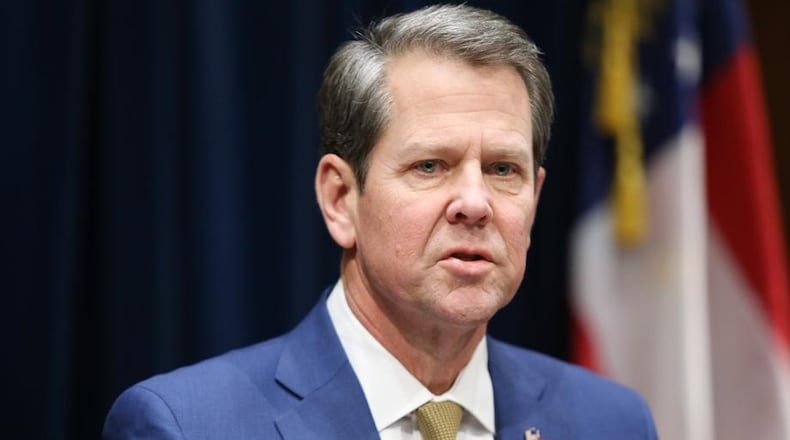For every dollar state agencies are proposing to cut to meet Gov. Brian Kemp’s order to slow spending, they’re requesting nearly two more to pay for programs, from education and health care to law clerks and fighting gangs.
That’s because not all agencies are equal when it comes to cutting, or adding spending.
State budget-writing is an exercise in addition and subtraction and what’s spent often depends on whether funding is based on how many people use services, and the priorities of governors and lawmakers. The result of Kemp’s call to reduce spending this year — starting Oct. 1 — by 4 percent, and 6 percent next year, is no different.
While several agencies proposed cutting jobs and programs, K-12 schools and colleges requested about $400 million in additional funding this year and next to meet enrollment growth, and the agency that runs Medicaid, the health care program for the poor, disabled and elderly, asked for nearly $300 million, according to a review of budget plans by the Atlanta Journal-Constitution.
Some of the most costly things the state does — educating students, providing health care to the poor, and building roads — were exempt from Kemp’s edict to cut spending. In fact, about three-fourths of what the state spends — much of it for programs that are funded based on the number of Georgians enrolled in them — didn’t have to be cut back. Many of those areas asked for more money because their costs are rising.
“Most of government is people driven, driven by the number of people who come through the door,” said Ben Harbin, a former Republican lawmaker who headed the state House Appropriations Committee during the Great Recession. “Education is seats in the desk. Medicaid is people walking into the doctor’s office. You can’t cut that.
“You can say you want to spend less on it, but then you are cutting people. There is no way to cut those two things.”
Kemp ordered the cuts in August to both prepare the state in case of an economic downturn and provide the money needed to meet his priorities, such as higher teacher pay.
While K-12 school funding and the massive Medicaid program are exempt, agencies on the hook for cuts include the departments of Agriculture, Corrections, Driver Services, Public Health, public defenders, the Georgia State Patrol, the GBI, most of the Department of Natural Resources, and the administration of K-12 schools and colleges.
Many of them submitted budget plans showing that they will cut jobs, the first significant reductions since the Great Recession.
About $219 million would be cut this year and $310 million in fiscal 2021, which begins July 1, 2020.
Danny Kanso, an analyst for the left-leaning Georgia Budget & Policy Institute, said it’s hard to understand how eliminating the jobs of Georgia Bureau of Investigations forensic scientists and investigators, and cutting funding to domestic violence shelters and sexual assault centers, mental health, economic development and school nutrition programs — all of which were proposed — would help prepare the state for a recession.
“It would be really shocking, unless we think we are in a major downturn, that we would choose to pull millions of dollars from those areas,” said Kanso. “It’s unclear what purpose that would serve.”
But state tax collections slowed the first two months of this fiscal year, which could be a sign of a slowing economy or that a cut in income tax rates lawmakers approved means less money is coming in.
“It’s just the beginning of the fiscal year, but you can readily see why Gov. Kemp is being cautious about proceeding to spend the budget passed last session,” wrote Senate Appropriations Chairman Jack Hill, R-Reidsville, in his weekly newsletter.
“Whether it is the income tax cut passed last year that started in January or some other factor adversely affecting Georgia’s revenue growth, there is little doubt Georgia has something amiss in its revenue collections.”
At the same time some agencies are proposing big cuts, others have asked for more money this year and next. An AJC review of plans showed about $190 million in requests for this year and more than $700 million in fiscal 2021.
The biggest chunk would go to run Georgia schools and universities. They receive money from the state based on enrollment, so when the number of students and cost goes up, so does what the state contributes.
“Enrollment-driven programs have cost increases every year,” said Kanso, who served as an aide to former Lt. Gov. Casey Cagle. “That’s kind of what happens normally.”
The agency that runs the HOPE scholarship program requested an extra $78 million next year to meet the expected need for college scholarship and grant money. Many of the agency’s programs, like HOPE, are funded by lottery ticket sales. But it also asked for more money for two that aren’t: one for a very popular program that allows high school students to earn college credits, and another that provides grants to Georgians attending a private college in the state.
The court system asked for about a $7 million increase, including new law clerks, assistant district attorneys, and support staff for the Court of Appeals and Supreme Court. Since the courts are a separate branch of government, the governor has to submit their requests to the General Assembly without making changes to their proposals.
The agency that runs the state patrol requested $2.47 million for a new group of trooper recruits next year. In the budget line above the request, the Department of Public Safety notes it will have to cut $8.3 million from “field services and operations,” per the governor’s request.
The Georgia Bureau of Investigations said it would eliminate jobs of forensic scientists and investigators, but asked for about $2.3 million in fiscal 2020 and 2021 for one of Kemp’s top campaign pledges, a task force to crack down on gangs.
Most of the requests that were made were fairly routine, the kind that governors and lawmakers see every year.
The governor's decision to exempt so much of state spending from cuts means he may not have to consider the widespread reductions that occurred during the Great Recession.
Then, tens of thousands of teachers and state employees were forced to take furlough days without pay. And those were the lucky ones, since many others were laid off. Funding, even for historically hard-to-cut programs, was reduced.
But, even then, some agencies were hit a lot harder than others.
“We cut Department of Natural Resources and agriculture 45 percent. We cut education three percent,” Harbin said. “There are certain things you just have to fund.”
BUDGET CUTS
The Kemp administration directed state agencies to identify cuts to their budgets for fiscal 2020,which ends June 30,and fiscal 2021.
4%
The amount agencies were told to identify in cuts to their budgets this fiscal year.
6%
The amount agencies were told to identify in cuts to their budgets for the next fiscal year.
Exempted
Big enrollment-driven programs such as K-12 schools, universities and Medicaid will be spared.
TOTAL AMOUNT TO BE CUT FOR THIS YEAR:
About $219 million
NEXT YEAR
$310 million
About the Author
Keep Reading
The Latest
Featured




